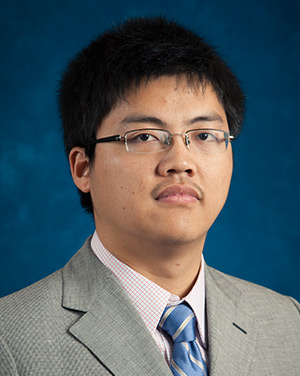Facial Recognition Systems
Constructing 3D Images from 2D Images
From the curve of a person’s cheekbone to the proportion of their nose and eyes, every face is unique. So unique that, similar to fingerprints, a person’s facial features can serve as identification.
 Pengfei Dou, a Ph.D. student in computer science, recently defended his thesis, and
accepted a job offer in the tech industry.Facial recognition systems work by identifying characteristic features from a subject’s
face, analyzing their appearance, relative size, position and shape. This information
can then be used for everything from automatic tagging of social media photos to unlocking
a smartphone.
Pengfei Dou, a Ph.D. student in computer science, recently defended his thesis, and
accepted a job offer in the tech industry.Facial recognition systems work by identifying characteristic features from a subject’s
face, analyzing their appearance, relative size, position and shape. This information
can then be used for everything from automatic tagging of social media photos to unlocking
a smartphone.
Using Photos to Construct a 3D Facial Image
Pengfei Dou, a Ph.D. student in computer science at the University of Houston, works on improving methods for facial recognition. His research, which was advised by Ioannis A. Kakadiaris, Hugh Roy and Lillie Cranz Cullen University Professor of Computer Science, focuses on using two-dimensional images, such as photos, to create a three-dimensional facial model.
This three-dimensional reconstruction, when used in other contexts, increases the robustness of facial recognition, including photos where facial poses and expressions have changed.
“A three-dimensional facial model works better for facial recognition, however, it’s not always practical to get one,” Dou said.
Deep Learning Enables Reconstruction
In order to reconstruct a three-dimensional model from a photo, Dou uses deep learning, which is a powerful machine learning technique. Machine learning works by giving computers large amounts of data, which trains them to learn how to perform specific tasks. This can be used to spot patterns and make predictions.
Deep learning uses artificial neural networks, loosely modeled on the way neurons connect with each other, which are assembled into layers which sequentially analyze patterns. This deepens the size and complexity of a computer’s ability to learn and process information.
Dou’s research was based on two different scenarios. In the first scenario, the task was to reconstruct a three-dimensional facial model from a single photo. In the second scenario, the task of reconstructing a three-dimensional facial model included multiple photos.
“For cases where we had multiple two-dimensional images, we were able to reconstruct a better three-dimensional facial model,” Dou said.
Problem-Driven Research
Dou, who recently defended his thesis, has already accepted a job offer in the tech industry, where he’ll continue to work on novel computer vision techniques.
When asked about his experience as a graduate student, Dou noted that the projects for his graduate courses helped him try out new techniques. Meanwhile, his advisor expected the highest possible quality of work from him, both in his research, as well as his coursework.
“The research conducted in our lab has always been motivated by practical problems that needed to be solved,” Dou said.
- Rachel Fairbank, College of Natural Sciences and Mathematics
December 6, 2017